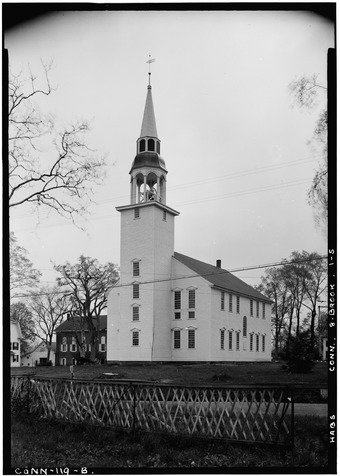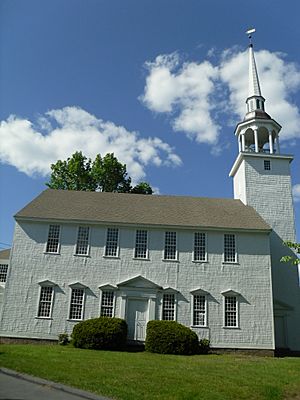Unitarian Meetinghouse facts for kids
|
Unitarian Meetinghouse
|
|
|
U.S. Historic district
Contributing property |
|

Meetinghouse in 1940
|
|
| Location | 7 Hartford Rd., Brooklyn, Connecticut |
|---|---|
| Area | 2 acres (0.81 ha) |
| Built | 1771 |
| Architect | Tyler, Daniel; Et al. |
| Architectural style | Georgian; Greek Revival |
| Part of | Brooklyn Green Historic District (ID82004401) |
| NRHP reference No. | 72001335 |
Quick facts for kids Significant dates |
|
| Added to NRHP | November 9, 1972 |
| Designated CP | September 23, 1982 |
The Unitarian Meetinghouse is a very old church located in Brooklyn, Connecticut. It stands where Connecticut Routes 169 and 6 meet. This building was constructed in 1771.
It is one of the few church buildings in Connecticut that existed before the American Revolution. The meetinghouse is special because its history is well-documented. This helped people restore it to its original look. It still has its old design, with the main door on the longer side. The pulpit, where the speaker stands, is on the opposite side. A bell tower with a steeple is at one of the shorter ends. This design hints at how churches changed in the 1800s. The building was added to the National Register of Historic Places in 1972.
Contents
History of the Meetinghouse
Early Beginnings in Brooklyn
When Brooklyn was first settled in the early 1700s, its land was part of two other towns. These towns were Pomfret and Canterbury. The church group, or congregation, started in 1731. It was first known as the Mortlake Society.
Their first meeting house was built in 1734. It was called the Second Church in Pomfret. The church building you see today was built between 1771 and 1774. The town of Brooklyn officially became a town in 1786.
Building Challenges and Changes
Building the meetinghouse was first suggested in 1763. However, it faced opposition for many years. Local Anglicans, who were members of the Church of England, did not agree with the plan. This disagreement led to the building of Trinity Church instead.
In the early 1800s, the congregation faced another split. Some members were Trinitarians, believing in the Holy Trinity. Others were Unitarians, who had different beliefs about God. The Unitarians eventually gained control of this building.
Restoration and Modern Era
The building was changed in 1845. The entrance was moved to a new tower on the side. A full second floor was added at the gallery level. The old box pews and pulpit were also replaced.
However, in the late 1900s, all these interior changes were reversed. The goal was to bring the building back to its original 1771 appearance. The tower remained, but its steeple was replaced after the powerful New England Hurricane of 1938.
Important People and Ownership
The Unitarian Universalist Society in Brooklyn, CT, owns and takes care of the building today. This society is the direct descendant of Connecticut's first Unitarian congregation.
Notable Ministers
The first Unitarian minister of this church was Reverend Samuel May. He was famous for many things. He worked for peace and helped improve education. He also supported temperance, which meant avoiding alcohol. Reverend May was a strong supporter of women's rights. He was one of the main people who helped Prudence Crandall. She is known as the official female hero of Connecticut.
In 1871, the Unitarian Universalist Society made history. They ordained Reverend Celia Burleigh. She was the first female Unitarian minister. She was also one of the first women to be officially ordained as a minister in any church group.
See also




